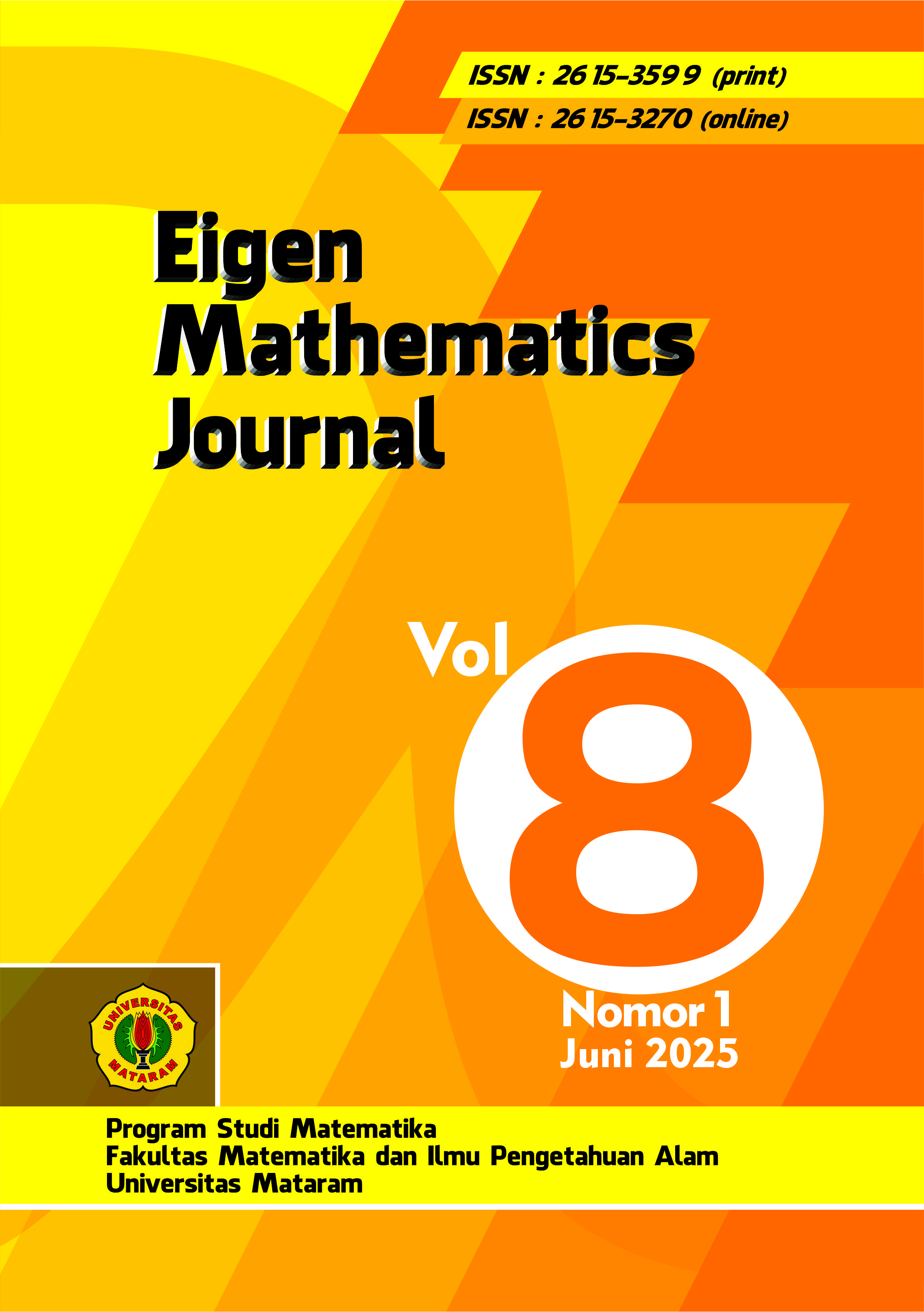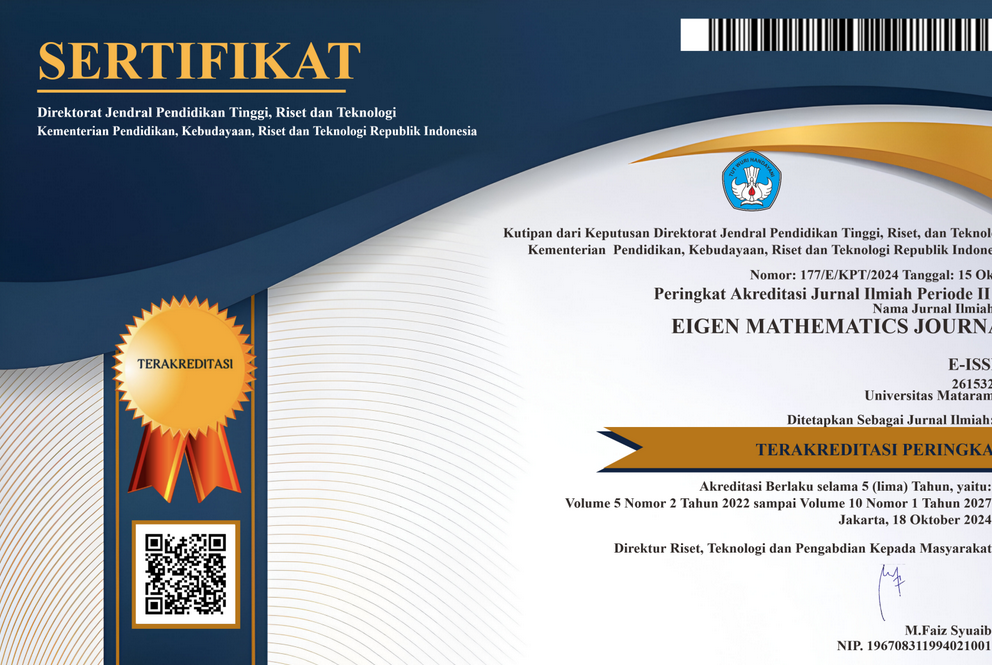Integrative Bioinformatics and Statistical Approaches for Identifying Prognostic Biomarkers and Therapeutic Targets in Breast Cancer
DOI:
https://doi.org/10.29303/emj.v8i1.277Keywords:
Breast cancer, Prognostic biomarkers, Protein-protein interaction, Survival analysis, Cell cycle regulationAbstract
Breast cancer is a leading cause of cancer-related mortality worldwide, necessitating the identification of reliable biomarkers for prognosis and targeted therapy. This study employed an integrative bioinformatics and statistical approach to analyze differentially expressed genes (DEGs) in breast cancer using datasets GSE70947 and GSE22820 from the gene expression omnibus (GEO). A protein-protein interaction (PPI) network was constructed to identify hub genes, followed by functional enrichment analysis to determine their biological significance. Survival analysis using the KMplot database revealed that CDC45, KIF2C, CCNB1, KIF4A, CENPE, CHEK1, KIF15, AURKB, NCAPG, and HJURP were significantly associated with poor prognosis. These genes were primarily enriched in cell cycle regulation, mitotic spindle organization, and DNA damage response, highlighting their role in tumor progression. Among them, CCNB1, CHEK1, and AURKB were strongly linked to cell cycle progression and checkpoint regulation, while KIF2C and CENPE played essential roles in mitotic division. High expression levels of these genes correlated with reduced overall survival, suggesting their potential as prognostic biomarkers and therapeutic targets in breast cancer.These discoveries help us better understand how breast cancer develops and point to potential targets for tailored treatments.References
L. Newman, “Oncologic anthropology: global variations in breast cancer risk, biology, and outcome,” Journal of Surgical Oncology, vol. 128, no. 6, pp. 959–966, 2023. https://doi.org/10.1002/jso.27459.
H. Sung, J. Ferlay, R. L. Siegel, M. Laversanne, I. Soerjomataram, A. Jemal, and F. Bray, “Global cancer statistics 2020: Globocan estimates of incidence and mortality worldwide for 36 cancers in 185 countries,” CA: a cancer journal for clinicians, vol. 71, no. 3, pp. 209–249, 2021. https://doi.org/10.3322/caac.21660.
L. Wilkinson and T. Gathani, “Understanding breast cancer as a global health concern,” The British journal of radiology, vol. 95, no. 1130, p. 20211033, 2022. https://doi.org/10.1259/bjr.20211033.
H. Chen, T. Tian, H. Luo, and Y. Jiang, “Identification of differentially expressed genes at the single-cell level and prognosis prediction through bulk rna sequencing data in breast cancer,” Frontiers in Genetics, vol. 13, p. 979829, 2022. https://doi.org/10.3389/fgene.2022.979829.
L. Chen, Y.-H. Zhang, S. Wang, Y. Zhang, T. Huang, and Y.-D. Cai, “Prediction and analysis of essential genes using the enrichments of gene ontology and kegg pathways,” PloS one, vol. 12, no. 9, p. e0184129, 2017. https://doi.org/10.1371/journal.pone.0184129.
S. Supplitt, P. Karpinski, M. Sasiadek, and I. Laczmanska, “Current achievements and applications of transcriptomics in personalized cancer medicine,” International Journal of Molecular Sciences, vol. 22, no. 3, p. 1422, 2021. https://doi.org/10.3390/ijms22031422.
M. S. Alam, A. Sultana, M. S. Reza, M. Amanullah, S. R. Kabir, and M. N. H. Mollah, “Integrated bioinformatics and statistical approaches to explore molecular biomarkers for breast cancer diagnosis, prognosis and therapies,” PloS one, vol. 17, no. 5, p. e0268967, 2022. https://doi.org/10.1371/journal.pone.0268967.
J.-L. Deng, Y.-h. Xu, and G. Wang, “Identification of potential crucial genes and key pathways in breast cancer using bioinformatic analysis,” Frontiers in genetics, vol. 10, p. 695, 2019. https://doi.org/10.3389/fgene.2019.00695.
C. C. Wang, C. Y. Li, J.-H. Cai, P. C.-Y. Sheu, J. J. Tsai, M.-Y. Wu, C.-J. Li, and M.-F. Hou, “Identification of prognostic candidate genes in breast cancer by integrated bioinformatic analysis,” Journal of clinical medicine, vol. 8, no. 8, p. 1160, 2019. https://doi.org/10.3390/jcm8081160.
S. Zhang, H. Jiang, B. Gao, W. Yang, and G. Wang, “Identification of diagnostic markers for breast cancer based on differential gene expression and pathway network,” Frontiers in Cell and Developmental Biology, vol. 9, p. 811585, 2022. https://doi.org/10.3389/fcell.2021.811585.
M. K. Kerr, “Linear models for microarray data analysis: hidden similarities and differences,” Journal of Computational Biology, vol. 10, no. 6, pp. 891–901, 2003. https://doi.org/10.1089/106652703322756131.
X. Mengyan, D. Kun, J. Xinming, W. Yutian, and S. Yongqian, “Identification and verification of hub genes associated with the progression of non-small cell lung cancer by integrated analysis,” Frontiers in pharmacology, vol. 13, p. 997842, 2022. https://doi.org/10.3389/fphar.2022.997842.
I. Pérez de Castro, G. de Cárcer, and M. Malumbres, “A census of mitotic cancer genes: new insights into tumor cell biology and cancer therapy,” Carcinogenesis, vol. 28, no. 5, pp. 899–912, 2007. https://doi.org/10.1093/CARCIN/BGM019.
H. Lee, A. H. Trainer, L. S. Friedman, F. C. Thistlethwaite, M. J. Evans, B. A. Ponder, and A. R. Venkitaraman, “Mitotic checkpoint inactivation fosters transformation in cells lacking the breast cancer susceptibility gene, brca2,” Molecular cell, vol. 4, no. 1, pp. 1–10, 1999. https://doi.org/10.1016/S1097-2765(00)80182-3.
B. Gyorffy, A. Lanczky, and Z. Szallasi, “P1-07-18: Expanding an online tool for genome-wide validation of survival-associated biomarkers in breast and ovarian cancer using microarray data of 3,862 patients.,” Cancer Research, vol. 71, no. 24_Supplement, pp. P1–07, 2011. https://doi.org/10.1158/0008-5472.SABCS11-P1-07-18.
B. Gyorffy, A. Lánczky, Z. Szállási, et al., “Implementing an online tool for genome-wide validation of survival-associated biomarkers in ovarian-cancer using microarray data from 1287 patients,” Endocrine Related Cancer, vol. 19, no. 2, p. 197, 2012. https://doi.org/10.1530/ERC-11-0329.
G.-j. Qiao, L. Chen, J.-c. Wu, and Z.-r. Li, “Identification of an eight-gene signature for survival prediction for patients with hepatocellular carcinoma based on integrated bioinformatics analysis,” PeerJ, vol. 7, p. e6548, 2019. https://doi.org/10.7717/peerj.6548.
G. K. Smyth, “Limma: linear models for microarray data,” in Bioinformatics and computational biology solutions using R and Bioconductor, pp. 397–420, Springer, 2005. https://doi.org/10.1007/0-387-29362-0 23.
D. Szklarczyk, A. L. Gable, D. Lyon, A. Junge, S. Wyder, J. Huerta-Cepas, M. Simonovic, N. T. Doncheva, J. H. Morris, P. Bork, et al., “String v11: protein–protein association networks with increased coverage, supporting functional discovery in genome-wide experimental datasets,” Nucleic acids research, vol. 47, no. D1, pp. D607–D613, 2019. https://doi.org/10.1093/nar/gky1131.
P. Shannon, A. Markiel, O. Ozier, N. S. Baliga, J. T. Wang, D. Ramage, N. Amin, B. Schwikowski, and T. Ideker, “Cytoscape: a software environment for integrated models of biomolecular interaction networks,” Genome research, vol. 13, no. 11, pp. 2498–2504, 2003. https://genome.cshlp.org/content/13/11/2498.short.
C. Haythornthwaite, “Social network analysis: An approach and technique for the study of information exchange,” Library & information science research, vol. 18, no. 4, pp. 323–342, 1996. https://doi.org/10.1016/S0740-8188(96)90003-1.
G. Yu, L.-G. Wang, Y. Han, and Q.-Y. He, “clusterprofiler: an r package for comparing biological themes among gene clusters,” Omics: a journal of integrative biology, vol. 16, no. 5, pp. 284–287, 2012. https://doi.org/10.1089/omi.2011.0118.
C. Ju, “Determining overrepresentation of gene ontology terms using the hypergeometric distribution,” 2011. https://consensus.app/papers/determining-overrepresentation-of-gene-ontology-terms-ju/fb1f31912e425fe7909bdd8d421479ec/.
Á. Nagy, G. Munkácsy, and B. Győrffy, “Pancancer survival analysis of cancer hallmark genes,” Scientific reports, vol. 11, no. 1, p. 6047, 2021. https://doi.org/10.1038/s41598-021-84787-5.
L. Wu, G. Gao, H. Mi, Z. Luo, Z. Wang, Y. Liu, L. Wu, H. Long, and Y. Shen, “Validation of cdc45 as a novel biomarker for diagnosis and prognosis of gastric cancer,” PeerJ, vol. 12, p. e17130, 2024. https://doi.org/10.7717/peerj.17130.
R. Zhang, Z. Liu, and G. Zhang, “Cdc45 modulates mcm7 expression and inhibits cell proliferation by suppressing the pi3k/akt pathway in acute myeloid leukemia,” American journal of translational research, vol. 13, no. 9, p. 10218, 2021. https://pmc.ncbi.nlm.nih.gov/articles/PMC8507005/.
U. Eichenlaub-Ritter, “Microtubule dynamics and tumor invasion involving mcak,” 2015. https://doi.org/10.1080/15384101.2015.1093813.
H. H. Moon, N.-N. Kreis, A. Friemel, S. Roth, D. Schulte, C. Solbach, F. Louwen, J. Yuan, and A. Ritter, “Mitotic centromere-associated kinesin (mcak/kif2c) regulates cell migration and invasion by modulating microtubule dynamics and focal adhesion turnover,” Cancers, vol. 13, no. 22, p. 5673, 2021. https://doi.org/10.3390/cancers13225673.
Z. Gong, P. Ma, D. Zhou, T. Xu, and Y. Fang, “P19. 16. a the effect of targeting ccnb1 on the radiosensitivity of malignant meningioma,” Neuro-Oncology, vol. 26, no. Supplement_5, pp. v115–v115, 2024. https://doi.org/10.1093/neuonc/noae144.386.
H. Wang, C. Lu, Q. Li, J. Xie, T. Chen, Y. Tan, C. Wu, and J. Jiang, “The role of kif4a in doxorubicin-induced apoptosis in breast cancer cells,” Molecules and cells, vol. 37, no. 11, pp. 812–818, 2014. https://doi.org/10.14348/molcells.2014.0210.
T. Tomonaga, K. Matsushita, S. Yamaguchi, T. Oohashi, H. Shimada, T. Ochiai, K. Yoda, and F. Nomura, “Overexpression and mistargeting of centromere protein-a in human primary colorectal cancer,” Cancer research, vol. 63, no. 13, pp. 3511–3516, 2003. https://consensus.app/papers/overexpression-and-mistargeting-of-centromere-proteina-tomonaga-matsushita/1f21d69bf9f25fe1aaadffe895739c2b/.
X. Bai, J. Wang, L. Huo, Y. Xie, W. Xie, G. Xu, and M. Wang, “Serine/threonine kinase chek1-dependent transcriptional regulation of rad54l promotes proliferation and radio resistance in glioblastoma,” Translational oncology, vol. 11, no. 1, pp. 140–146, 2018. https://doi.org/10.1016/j.tranon.2017.11.007.
Q. Guo, P. Qiu, K. Pan, H. Liang, Z. Liu, and J. Lin, “Integrated machine learning algorithms identify kif15 as a potential prognostic biomarker and correlated with stemness in triple-negative breast cancer,” Scientific Reports, vol. 14, no. 1, p. 21449, 2024. https://doi.org/10.1038/s41598-024-72406-y.
S. Pellizzari, H. Athwal, A. C. Bonvissuto, and A. Parsyan, “Role of aurkb inhibition in reducing proliferation and enhancing effects of radiotherapy in triple-negative breast cancer,” Breast Cancer: Targets and Therapy, pp. 341–346, 2024. https://doi.org/10.2147/BCTT.S444965.
Y. Wang, B. Gao, P. Y. Tan, Y. A. Handoko, K. Sekar, A. Deivasigamani, V. P. Seshachalam, H.-Y. OuYang, M. Shi, C. Xie, et al., “Genome-wide crispr knockout screens identify ncapg as an essential oncogene for hepatocellular carcinoma tumor growth,” The FASEB Journal, vol. 33, no. 8, p. 8759, 2019. https://doi.org/10.1096/fj.201802213RR.
L. Li, Q. Yuan, Y.-M. Chu, H.-Y. Jiang, J.-H. Zhao, Q. Su, D.-Q. Huo, and X.-F. Zhang, “Advances in holliday junction recognition protein (hjurp): Structure, molecular functions, and roles in cancer,” Frontiers in Cell and Developmental Biology, vol. 11, p. 1106638, 2023. https://doi.org/10.3389/fcell.2023.1106638.
T. Alfonso-Pérez, D. Hayward, J. Holder, U. Gruneberg, and F. A. Barr, “Mad1-dependent recruitment of cdk1-ccnb1 to kinetochores promotes spindle checkpoint signaling,” Journal of Cell Biology, vol. 218, no. 4, pp. 1108–1117, 2019. https://doi.org/10.1083/jcb.201808015.
S. McNeely, R. Beckmann, and A. B. Lin, “Chek again: revisiting the development of chk1 inhibitors for cancer therapy,” Pharmacology & therapeutics, vol. 142, no. 1, pp. 1–10, 2014. https://doi.org/10.1016/j.pharmthera.2013.10.005.
B. Nickkholgh, S. Sittadjody, K. Ordonez, M. B. Rothberg, and K. Balaji, “Protein kinase d1 induces g1-phase cell-cycle arrest independent of checkpoint kinases by phosphorylating cell division cycle phosphatase 25,” The Prostate, vol. 79, no. 9, pp. 1053–1058, 2019. https://doi.org/10.1002/pros.23807.
M.-H. Rong, J.-D. Li, L.-Y. Zhong, Y.-Z. Huang, J. Chen, L.-Y. Xie, R.-X. Qin, X.-L. He, Z.-H. Zhu, S.-N. Huang, et al., “Ccnb1 promotes the development of hepatocellular carcinoma by mediating dna replication in the cell cycle,” Experimental Biology and Medicine, vol. 247, no. 5, pp. 395–408, 2022. https://doi.org/10.1177/15353702211049149.
K.-W. Yu, N. Zhong, Y. Xiao, and Z.-Y. She, “Mechanisms of kinesin-7 cenp-e in kinetochore–microtubule capture and chromosome alignment during cell division,” Biology of the Cell, vol. 111, no. 6, pp. 143–160, 2019. https://doi.org/10.1111/boc.201800082.
C. Zhu, J. Zhao, M. Bibikova, J. D. Leverson, E. Bossy-Wetzel, J.-B. Fan, R. T. Abraham, and W. Jiang, “Functional analysis of human microtubule-based motor proteins, the kinesins and dyneins, in mitosis/cytokinesis using rna interference,” Molecular biology of the cell, vol. 16, no. 7, pp. 3187–3199, 2005. https://doi.org/10.1091/mbc.e05-02-0167.
Downloads
Published
How to Cite
Issue
Section
License

This work is licensed under a Creative Commons Attribution-NonCommercial-ShareAlike 4.0 International License.
All articles published in the Eigen Mathematics Journal will be available for free reading and downloading. The license applied to this journal is Creative Commons Attribution-Non-Commercial-Share Alike (CC BY-NC-SA).
Most read articles by the same author(s)
- Zulhan Widya Baskara, Lisa Harsyiah, Dewa Nyoman Adi Paramartha, Qabul Dinanta Utama, Factor Analysis for Mapping Characteristics in Robusta Coffee Decaffeination Experiments , EIGEN MATHEMATICS JOURNAL: Vol. 5 No. 1 Juni 2022
- Baiq Siti Patimah Zohrah, Syamsul Bahri, Zulhan Widya Baskara, Forecasting Non-Metal and Rock Mineral (MBLB) Tax Revenue Using the Fuzzy Time Series Markov Chain Method in East Lombok Regency , EIGEN MATHEMATICS JOURNAL: Vol. 7 No. 1 (2024): June
- Muhammad Rizaldi, Nurul Fitriyani, Zulhan Widya Baskara, Modeling of Economic Growth Rate in West Nusa Tenggara Province with Longitudinal Kernel Nonparametric Regression , EIGEN MATHEMATICS JOURNAL: Vol. 7 No. 1 (2024): June
- Lisa Harsyiah, Zulhan Widya Baskara, Dina Eka Putri, Rifdah Fadhilah, Analysis of Factors that Influence Poverty in West Nusa Tenggara Using Principal Component Regression , EIGEN MATHEMATICS JOURNAL: Vol. 8 No. 1 (2025): June






